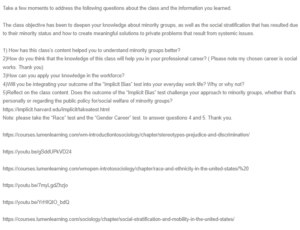Discussion – Minority Groups
How the class’s content has helped me understand minority groups better
The content of this class has helped me take a closer look into the history of minorities in America. Reading about the challenges that minorities face, particularly discrimination and abuse, and how those challenges have evolved in the modern world has opened my mind to many social injustices that minorities face every day. I had the chance to understand the profundity of inequalities that minorities are treated within schools, job opportunities, the criminal justice system, health care, and housing, just to name a few. I now understand how the minorities are disadvantaged and treated unfairly in society, and the consequences are drug abuse, violence, increased rates of crimes, school dropouts, homelessness, poverty, high rates of imprisonment, among others.
The significance of the knowledge of this class in social work
As a social worker, my job is wholly concerned with families, individuals, communities, and groups. This is in endeavors to address fundamental needs, enhance collective liability, social working collective responsibility, and ideal health. With my in-depth comprehension of minority groups’ challenges, I am now more sensitive to oppression and discrimination. I have also learned essential matters, including cultural humility, cultural sensitivity, cultural awareness, cultural responsiveness, and cultural competence. I trust that with this knowledge, I will be able to effectively help those in need and be part of the changes needed to create an equality system for everyone.
Application of this knowledge in the workforce
With the knowledge that a vast population of minorities has been left in impoverished circumstances due to discrimination, my efforts as a social worker would be to help as many of them as possible. Among others, from drug rehabilitation, finding employment opportunities, finding ways to provide free healthcare services, and cheap housing. I would also try to create awareness of the inequalities minorities face, fully intent on promoting social inclusion and creating stable societies.
“Implicit Bias” results in integration in everyday work life
I will not be integrating my outcome in my work in light of the fact that, as much as it is my goal is to focus on minority groups, I will help both majority and minority groups in the same way. I want to focus on minority groups because they are more likely to end up in needy situations than the majority group; hence, they need more help. For this reason, I will not be integrating the “Implicit Bias” outcomes into my everyday work-life.
The effects of the “Implicit Bias” test on my approach to minority groups
The results of the implicit bias test do not challenge my approach towards minority groups because the results showed that I have a preference towards them. I believe this would help personally and in regards to public policy for minority groups’ social welfare.
In conclusion, it is only through history that one can develop a better comprehension of the world. One cannot build a system on which to base their life without first understanding how the world works. By studying history, one gets a perfect picture of how societies functioned over the years so that one can understand why things are the way they are and how they work now. Additionally, by looking at how things that still negatively affect us today started off, we can work on ways to fix them. Most of the social injustices people experience today are as a result of crimes committed years ago. By looking back at our predecessors’ mistakes and learning from them, we can only ensure that those who come after us will have a better functioning society.
References
Race and Ethnicity in the United States | Introduction to Sociology. Courses.lumenlearning.com
Stereotypes, Prejudice, and Discrimination | Introduction to Sociology. Courses.lumenlearning.com. https://courses.lumenlearning.com/wm-introductiontosociology/chapter/stereotypes-prejudice-and-discrimination/
Social Stratification and Mobility in the United States | Introduction to Sociology. Courses.lumenlearning.com. https://courses.lumenlearning.com/sociology/chapter/social-stratification-and-mobility-in-the-united-states/
Race & Ethnicity: Crash Course Sociology # 39. YouTube.com. https://www.youtube.com/watch?v=7myLgdZhzjo
ORDER A PLAGIARISM-FREE PAPER HERE
We’ll write everything from scratch
Question
Take a few moments to address the following questions about the class and the information you learned.
The class objective has been to deepen your knowledge about minority groups, as well as the social stratification that has resulted due to their minority status and how to create meaningful solutions to private problems that result from systemic issues.

Discussion – Minority Groups
1) How has this class’s content helped you to understand minority groups better?
2)How do you think that the knowledge of this class will help you in your professional career? ( Please note my chosen career is social works. Thank you)
3)How can you apply your knowledge in the workforce?
4)Will you be integrating your outcome of the “Implicit Bias” test into your everyday work life? Why or why not?
5)Reflect on the class content. Does the outcome of the “Implicit Bias” test challenge your approach to minority groups, whether that’s personally or regarding the public policy for/social welfare of minority groups?
https://implicit.harvard.edu/implicit/takeatest.html
Note: please take the “Race” test and the “Gender Career” test. to answer questions 4 and 5. Thank you.
https://courses.lumenlearning.com/wmopen-introtosociology/chapter/race-and-ethnicity-in-the-united-states/%20
https://courses.lumenlearning.com/sociology/chapter/social-stratification-and-mobility-in-the-united-states/

